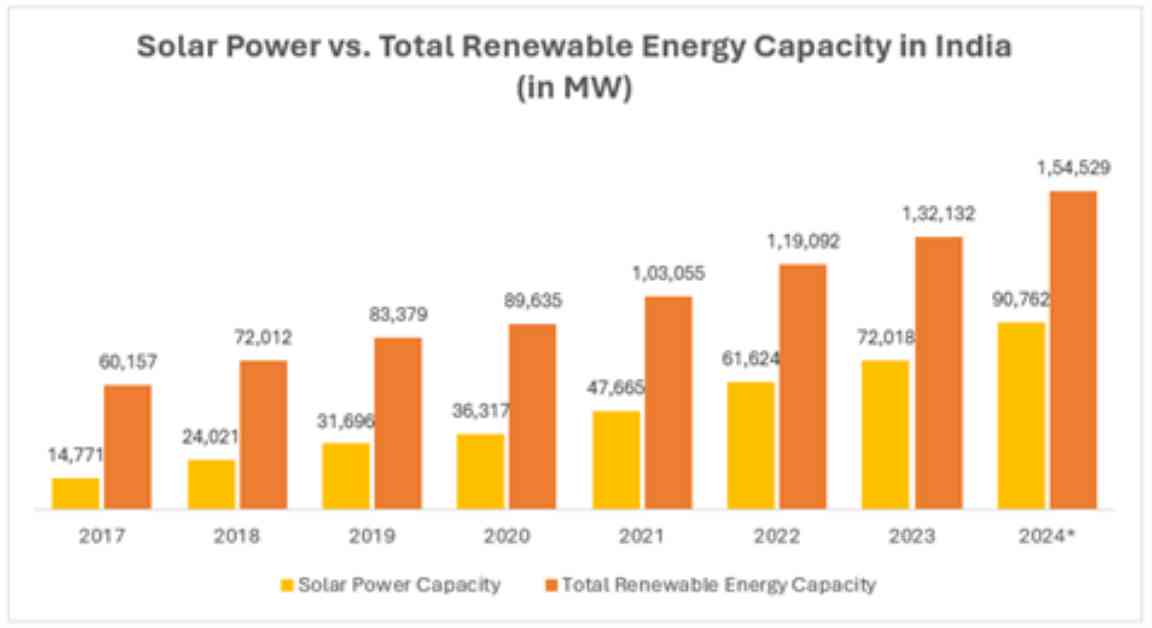India’s Solar Energy Revolution: A Bright Future Ahead
India is at the forefront of a solar energy revolution, harnessing its abundant natural resources to combat climate change and secure a sustainable energy future. With approximately 5000 trillion kWh of solar energy available, the country has set ambitious goals to harness this potential, with plans to increase solar capacity to 500 GW by 2030. This expansion plan is the largest in the world and marks a significant milestone in the global transition to renewable energy.
Breaking Records: India’s Solar Milestones
In recent years, India has made significant strides in solar energy production, surpassing countries like Germany to become a global leader in renewable energy. With a current capacity of 60.4 GW, the country has overtaken traditional powerhouses in the solar energy sector. States like Rajasthan, Gujarat, and Madhya Pradesh have emerged as power hubs, hosting some of the largest solar projects globally. The Bhadla Solar Park in Rajasthan, with a capacity of 2.2 GW, ranks as the third largest solar park worldwide.
Major Initiatives and Policies Driving Solar Growth
India’s solar growth is propelled by a robust policy framework and government initiatives that support the expansion of renewable energy infrastructure. The country has implemented various schemes like the Solar Park Scheme, VGF Schemes, and Grid Connected Solar Rooftop Schemes to encourage the adoption of solar energy. Additionally, the Renewable Purchase Obligation policy plays a crucial role in promoting solar energy adoption across different sectors.
Financial incentives, regulatory support, and competitive tariff rates have contributed to the success of solar power auctions in India. The country has achieved record-low tariffs, with rates falling below Rs. 2.50 per kWh, making solar energy a cost-effective alternative to traditional coal-fired power. India’s association with the International Solar Alliance (ISA) has attracted foreign investment and expertise, further bolstering the growth of the solar industry.
Empowering Communities: The Impact of Solar Initiatives
Government initiatives like the PM Suryodaya Yojana, later rebranded as PM Surya Ghar, are transforming the lives of ordinary citizens. By installing solar panels on ten million homes, the program aims to reduce electricity costs for middle-class families and make them self-sufficient in energy generation. Through rooftop solar panels, households can generate their electricity, receive 300 units free each month, and earn additional income by selling surplus electricity.
Technological Advancements Driving Solar Innovation
In addition to traditional solar panels, India is exploring advanced technologies like monocrystalline and polycrystalline PV modules to enhance solar efficiency. The country is also experimenting with bifacial solar modules that generate electricity from both sides, further optimizing energy production. Solar-powered agriculture pumps, rooftops, and floating solar projects are transforming rural and underserved regions, paving the way for a sustainable energy future.
Diversifying Energy Sources for a Resilient Future
While solar energy plays a significant role in India’s renewable energy landscape, the country is also exploring a mix of wind, hydro, biomass, and green hydrogen as alternative sources of clean energy. This diversified approach strengthens energy security and builds resilience in the face of fluctuating demands and regional resource constraints. The integration of digital tools, AI, and energy storage solutions like lithium-ion and solid-state batteries are optimizing energy management and forecasting for a more responsive and efficient energy system.
Challenges and Opportunities Ahead
Despite the progress made in the solar energy sector, India faces challenges related to the availability of rare earth elements (REEs) essential for solar technology. The complex extraction processes and geopolitical risks associated with REEs present hurdles for the country’s renewable energy goals. However, India is exploring its own reserves of REEs and investing in innovative technologies to enhance efficiency and reduce environmental impacts.
As the demand for solar energy continues to rise, India must address issues like land acquisition, intermittency, and import reliance to ensure a sustainable energy future. By investing in local manufacturing, decentralized solutions, and innovative recycling technologies, the country can overcome these challenges and pave the way for a cleaner, greener future.
Looking Ahead: A Sustainable Energy Future for India and the World
India’s commitment to solar energy represents a significant step towards a sustainable energy future, not just for the country but for the entire world. By leveraging its abundant solar resources, implementing innovative policies, and investing in cutting-edge technologies, India is setting an example for other nations to follow. As the global transition to renewable energy accelerates, India’s solar revolution serves as a beacon of hope for a greener, more sustainable future for generations to come.














